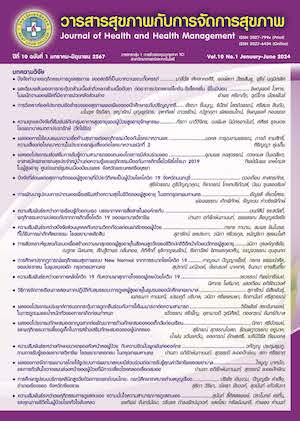Relationship between Self-learning, Organizational communication Atmosphere and Safety Behavior from COVID-19 Infection of the Professional Nurses
Keywords:
Self-Learning, Organizational Communication, Safety Behaviors from COVID 19, Professional NursesAbstract
This research objective was to study the relationship between self-learning Organizational communication atmosphere and safety behavior from COVID-19 infection of professional nurses The sample group consisted of professional nurses who had worked for more than 1 year in hospitals affiliated with the office. Permanent Secretary of the Ministry of Public Health in Nonthaburi Province, 93 people providing care to patients infected with COVID-19. Tools used to collect data include: Personal information questionnaire, Self-learning questionnaire, Organizational communication atmosphere questionnaire and questionnaire about safety behavior from COVID-19 infection which passed the content validity check and tested the reliability of the tool by testing the Cronbach’s alpha coefficient. Reliability values were .94, 1.00, and .98, respectively. Data were analyzed by finding frequency, percentage, mean, standard deviation, and Pearson’s correlation coefficient. The results of the research found that the organizational communication atmosphere was at a high level (Mean = 4.03, SD = .545), self-learning was at a high level (Mean = 3.88, SD = .411), and safety behavior from infection. COVID-19 is at a high level (Mean = 4.15, SD =.435). Self-learning and organizational communication atmosphere have a moderate level and significant positive relationship with safety behavior from COVID-19 infection. Statistically at the p<0.05 level (r = .674 and .502)
References
กรมควบคุมโรค กระทรวงสาธารณสุข. (2563). คู่มือเจ้าหน้าที่สาธารณสุขในการตอบโต้ภาวะฉุกเฉินกรณีการระบาดโรคติดเชื้อ ไวรัสโคโรนา 2019 ในประเทศไทย. สืบค้นจาก https://ddc.moph.go.th/viralpneumonia/file/g_other/G42_1.pdf
ฉวีฉัตร โฉลกคงถาวร. (2560). การศึกษาพฤติกรรมความปลอดภัยในการทำงานของพยาบาลวิชาชีพโรงพยาบาลมหาวิทยาลัยของรัฐ (วิทยานิพนธ์ปริญญามหาบัณฑิต). จุฬาลงกรณ์มหาวิทยาลัย, กรุงเทพฯ.
ดุษฎี อรรจน์อังกูร. (2561). ความต้องการในการพัฒนาตนเองของพยาบาลวิชาชีพ ในโรงพยาบาลมหาวิทยาลัยแห่งหนึ่ง (สารนิพนธ์ปริญญามหาบัณฑิต). มหาวิทยาลัยศรีนครินทรวิโรฒ, กรุงเทพฯ.
ทัศนีย์ สุนทร. (2558). ความสัมพันธ์ระหว่างการเรียนรู้ด้วยตนเอง ภาวะผู้นำของหัวหน้ากลุ่มงานกับการปฏิบัติงานของวิสัญญีพยาบาลโรงพยาบาลทั่วไป สังกัดกระทรวงสาธารณสุข (วิทยานิพนธ์ปริญญามหาบัณฑิต). จุฬาลงกรณ์มหาวิทยาลัย, กรุงเทพฯ.
นราจันทร์ ปัญญวุทโส, ปรัชญานันท์ เที่ยงจรรยา, และประภาพร ชูกำเนิด. (2565). ประสบการณ์ของพยาบาลวิชาชีพในการมีส่วนร่วมด้านความปลอดภัยในภาวะวิกฤตของการแพร่ระบาดโรคโควิด 19 โรงพยาบาลหาดใหญ่ ประเทศไทย. วารสารมหาวิทยาลัยคริสเตียน, 28(1), 59-72.
แพมาลา วัฒนเสถียรสินธุ์. (2559). ปัจจัยที่ส่งผลต่อปัญหาการสื่อสารในองค์กร กรณีศึกษา บริษัทยูไนเต็ด แสตนดาร์ด เทอร์มินัล จำกัด (มหาชน) (ค้นคว้าอิสระหลักสูตรบริหารธุรกิจมหาบัณฑิต). มหาวิทยาลัยธรรมศาสตร์, ปทุมธานี.
ยุพาพร ทองอินทร์. (2555). ความคิดเห็นเกี่ยวกับบรรยากาศการสื่อสารภายในองค์กรของพนักงานโรงแรม โมเวนฟิค รีสอร์ท แอนด์สปากะรนบีชภูเก็ต (วิทยานิพนธ์ปริญญามหาบัณฑิต). มหาวิทยาลัยศิลปากร, นครปฐม.
รัตน์ศิริ ทาโต. (2561). การวิจัยทางพยาบาลศาสตร์ : แนวคิดสู่การประยุกต์ใช้ (พิมพ์ครั้งที่ 4). กรุงเทพ: โรงพิมพ์แห่งจุฬาลงกรณ์มหาวิทยาลัย.
วรรณา จงจิตรไพศาล, อดุลย์ บัณฑุกุล, และกิติพงษ์ พนมยงค์. (2563). โปรแกรมปกป้องบุคลากรจากสถานการณ์การแพร่ระบาด COVID-19 สำหรับสถานบริการสาธารณสุข. กรุงเทพ: สถาบันอาชีวเวชศาสตร์และเวชศาสตร์สิ่งแวดล้อม กรมการแพทย์ กระทรวงสาธารณสุข.
วิจารณ์ พานิช. (2556). วิถีสร้างการเรียนรู้เพื่อศิษย์ในศตวรรษที่ 21. กรุงเทพ: มูลนิธิสดศรีสฤษดิ์วงศ์.
อุษา แก้วอำภา. (2545). ความสัมพันธ์ระหว่างบรรยากาศการสื่อสารขององค์การการเพิ่มคุณค่าในงานกับคุณภาพชีวิตการทำงานของพยาบาลประจำการ หน่วยงานอุบัติเหตุและฉุกเฉิน โรงพยาบาลศูนย์ (วิทยานิพนธ์ปริญญามหาบัณฑิต). จุฬาลงกรณ์มหาวิทยาลัย, กรุงเทพฯ.
Burns, N. and Grove, S.K. (2005) The Practice of Nursing Research: Conduct, Critique and Utilization. (5th ed). Missouri: Elsevier Saunders.
Chen, N., Zhou, M., Dong, X., Qu, J., Gong, F., Han, Y., ... & Zhang, L. (2020). Epidemiological and clinical characteristics of 99 cases of 2019 novel coronavirus pneumonia in Wuhan, China: a descriptive study. The lancet, 395(10223), 507-513.
Hair, J. F., Black, W. C., Babin, B. J. et al. (2010). Multivariate Data Analysis (7th ed.)., Pearson Prentice Hall.
Knowles, M. S. (1975). Self-directed learning. Association Press.
Marquis, B. L., & Huston, C. J. (2009). Leadership roles and management functions in nursing: Theory and application. China: Lippincott Williams & Wilkins.
Pace, W. R., & Faules, D. F. (1994). Organizational communication. (3rd ed.). New Jersey: Prentice-Hall.
Parker, S. K., Axtell, C. M., & Turner, N. (2001). Designing a safer workplace: importance of job autonomy, communication quality, and supportive supervisors. Journal of occupational health psychology, 6(3), 211-228.
Williamson, S. N. (2007). Development of a self-rating scale of self-directed learning. Nurse researcher, 14(2), 66-83.
Downloads
Published
How to Cite
Issue
Section
License
Copyright (c) 2024 Journal of health and health management

This work is licensed under a Creative Commons Attribution-NonCommercial-NoDerivatives 4.0 International License.




